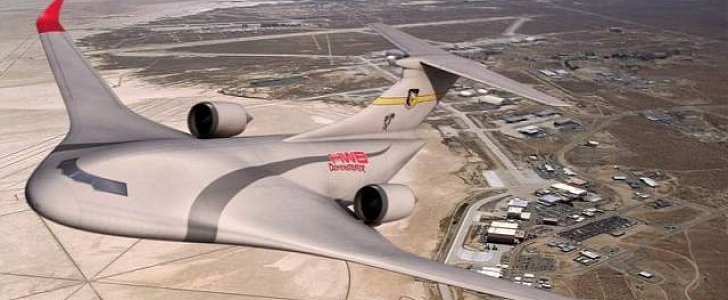Getting things greener and more fuel-efficient is not just a matter of on-road transportation, it concerns everything that goes from point A to point B, which includes aircraft. As one of the biggest players in the aeronautic industry, Lockheed Martin is getting closer and closer towards releasing a groundbreaking Hybrid Wing Body that will burn 70% less fuel than the Boeing C-17 while carrying the same amount of cargo.
Now, that’s a lot of savings in terms of fuel efficiency, but is it possible? The American global aerospace, defense and security company believes so, and they have been working on a concept that is turning out promising so far. The Hybrid Wing Body or HWB concept has been in the preps for about six years, and according to Aviation Week, they are getting closer and closer to creating a new-generation aircraft.
Over-wing nacelles make it easier to install large-diameter, fuel-efficient very-high-bypass engines. The concept combines a blended wing and forebody for increased aerodynamic and structural efficiency with a conventional art fuselage and tail. The best part is, the new technology still keeps compatibility with the existing airlift infrastructure and operations. In other words, the new does not replace the old but enhances it.
While the HWB retains a circular pressurized fuselage, additional unpressurized cargo bays exist in the inboard wing sections that can be accessed from the main cargo hold. As we said, the preliminary results are promising. According to the source, wind-tunnel tests confirm over-wing nacelles reduce drag by 5% compared with conventional under-wing engines.
Lockheed claims that retaining after fuselage and tail incur less that a 5% penalty, while it provides flight control compared with a pure blended wing-body configuration. Tests of 4%-scale semi-span model has proved the concept is working, validating the predicted aerodynamic efficiency of the HWB, the company claims. A concept for now, next year Lockheed will fly the scale model while the full-size aircraft should reach the sky around 2020.
Over-wing nacelles make it easier to install large-diameter, fuel-efficient very-high-bypass engines. The concept combines a blended wing and forebody for increased aerodynamic and structural efficiency with a conventional art fuselage and tail. The best part is, the new technology still keeps compatibility with the existing airlift infrastructure and operations. In other words, the new does not replace the old but enhances it.
While the HWB retains a circular pressurized fuselage, additional unpressurized cargo bays exist in the inboard wing sections that can be accessed from the main cargo hold. As we said, the preliminary results are promising. According to the source, wind-tunnel tests confirm over-wing nacelles reduce drag by 5% compared with conventional under-wing engines.
Lockheed claims that retaining after fuselage and tail incur less that a 5% penalty, while it provides flight control compared with a pure blended wing-body configuration. Tests of 4%-scale semi-span model has proved the concept is working, validating the predicted aerodynamic efficiency of the HWB, the company claims. A concept for now, next year Lockheed will fly the scale model while the full-size aircraft should reach the sky around 2020.


